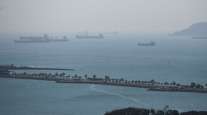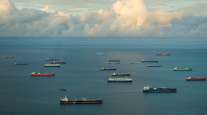Texas’ Port Freeport Stakes Its Claim on Cargo Boom

The idea of Port Freeport — 60 miles due south of downtown Houston on a marshy stretch of Texas Gulf Coast — as a titan of foreign trade might sound bananas.
Along with automobiles, its most well-developed business is, well, bananas brought in by the pallet by Dole and Chiquita. Yet Freeport has drawn support from local elected officials across the Houston region, who are drumming up support for spending potentially hundreds of millions of dollars to prepare local freight routes for the growing port to capitalize on an expected cargo boom from a wider Panama Canal.
"Time is of the essence," Fort Bend County Commissioner Andy Meyers told business and elected officials at a recent luncheon. "We need to move quickly to get decisions made."
It's an ambitious plan, even the strongest supporters say, for a port that trails its neighbors and handles around the equivalent of 1.1 million 20-foot cargo containers a year. The Texas ports of Houston, Beaumont, Corpus Christi and Port Arthur are in the top 20 nationally for foreign trade, based on tonnage.
While Freeport's no slouch, ranking No. 27 for foreign trade, officials see it as among those poised to benefit the most in Texas from bigger ships traversing the enlarged canal. Freeport has offerings larger state ports do not. It has the depth to handle larger ships, unlike Houston, and it has hundreds of acres of mitigated, open land ripe for development, unlike any of Texas' other ports.
Competition for that economic growth and the prized local jobs that come with more trade is intense, however. All of the ports along the eastern United States and Gulf Coast have aggressive plans for how they will capture that Panama Canal windfall, with Houston and Corpus Christi in the midst of aggressive expansions.
"There is almost this gold-rush mentality that if you build it, more of those ships will come," said Joseph Kane, a researcher with the Brookings Institution's Metropolitan Policy Program.
Projections for Freeport paint a successful future with many more cargo ships in port and more than 10,000 new jobs. Freeport's cargo handling could more than triple, said Alexander Metcalf, president of Transportation Economics & Management Systems Inc., which has prepared various analyses of the port's potential.
Based on Metcalf's analysis, Freeport officials want to be a competitor with other major U.S. cargo ports not only so it can deliver goods to Houston, but so it can eventually become the de facto entry point for Asian and Latin American containers to Dallas, and from there, the Midwest.
With the U.S.-bound container traffic, especially from Asia, expected to increase over the coming years, ports along the Gulf Coast are investing in newer and better facilities, hoping to lure shippers and the potential on-shore jobs they promise.
To prepare for the new ships and potentially increased demands, Freeport is preparing to move on a project that would expand its port operations from two large cranes capable of loading and unloading vessels to four cranes "as soon as possible," Metcalf said. Eventually, the port might need up to 12 of the massive cranes, three times the number of major cranes the Port of Houston offers, he said.
Freeport also has room to grow, unlike some of its regional peers that are hemmed in by development. At 186 acres, the port's developed area is not massive. To get there along Texas Highway 36, trucks must drive across the Brazos River where a marshy expanse stretches along both sides of the road. About 1,400 acres of that grassland is mitigated and available for development, said Al Durel, Port Freeport's director of operations.



